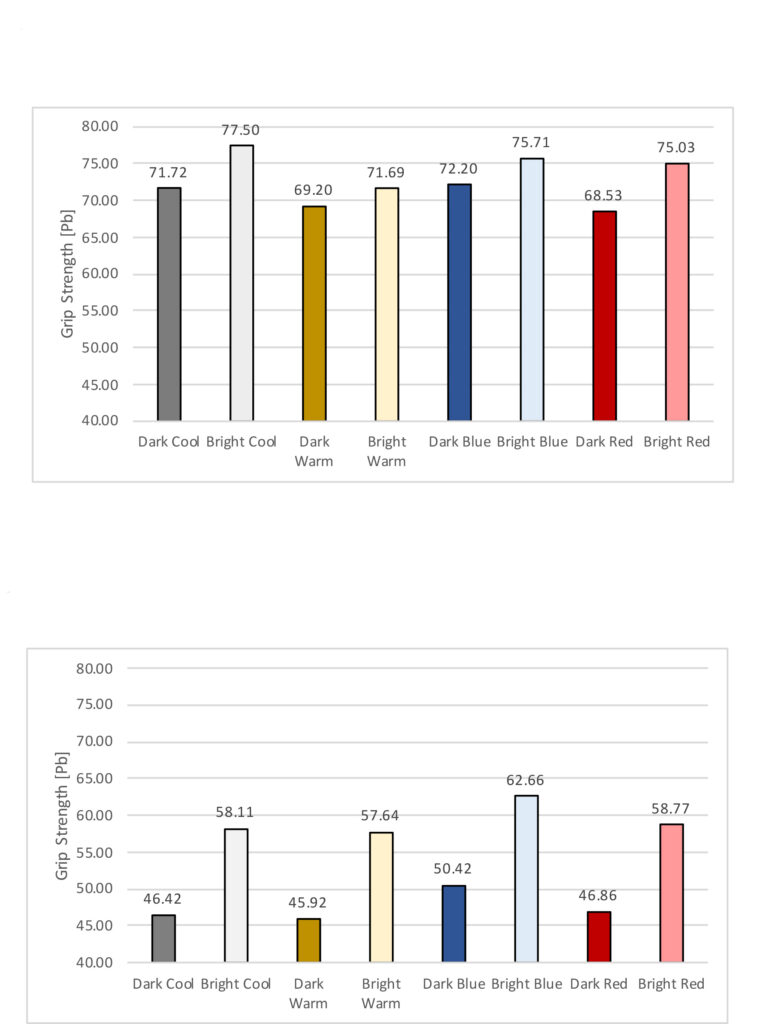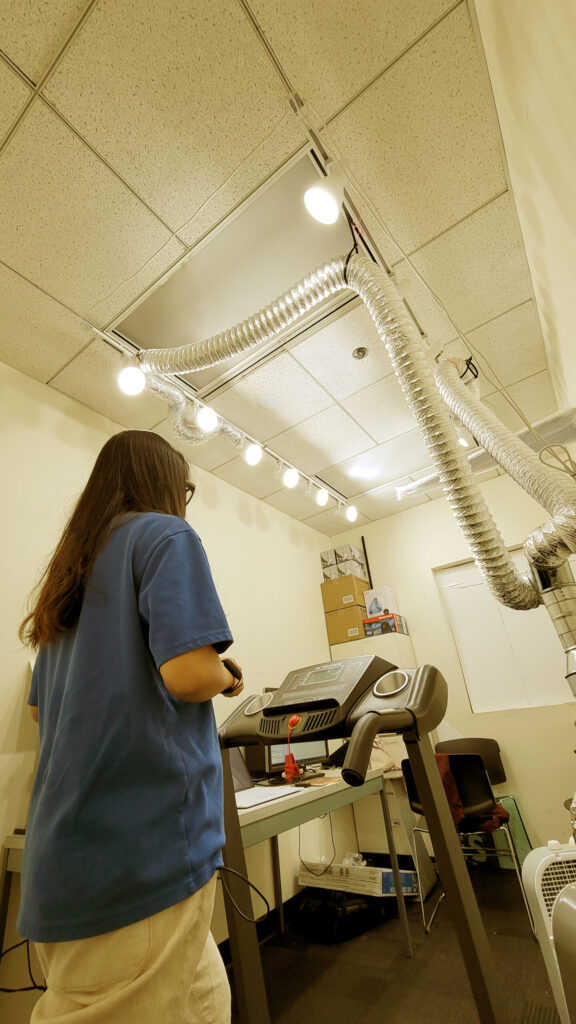When it comes to physical training, the environment individuals choose can significantly enhance their performance. A recent study by researchers at Arizona State University and the California Lighting Technology Center at the University of California, Davis explores indoor lighting and its influence on physiological signals in humans during exercise. This research aimed to understand the connection between different indoor lighting conditions, the body’s signals and physical training performance, while also considering the impact of biological sex. While under various lighting conditions, the study collected data for three physiological signals—pupil size, hand-grip strength and heart rate—during or soon after walking on a treadmill.
Methodology
The experiments took place in a room at Arizona State University equipped with twelve LED smart lights and a lighting control system that allowed the researchers to vary the lighting intensity, CCT and color (Figure 1). The experiment room had a west-facing window, which was covered during the experiment to eliminate daylight interference, and the indoor temperature was maintained at 71.6 deg Fahrenheit (22 deg Celsius).
A total of 64 participants (32 males and 32 females) were included in the experiment. Upon arrival, participants underwent baseline measurements using sensors under standard white light conditions (at 250 lux). Treadmill walking was chosen as a cardio activity for the study, and a treadmill was used to provide and measure the participants’ physical training performance. Participants were randomly assigned to one of eight experimental lighting conditions (warm white, blue, red, cool white) at two different luminance levels (at 150 or 400 lux) in Figure 2. Efforts were made to ensure an equal distribution of male and female participants across each lighting condition. Participants acclimated to the assigned lighting while seated, followed by a 20-minute treadmill walk at a speed of three miles per hour.
Post-exercise, participants rested, during which they completed another survey, and measurements of hand-grip strength, pupil size and heart rate were recorded. These measurements were chosen to understand the impact of the body’s signals and additional physical training performance after the cardio activity on the treadmill. For monitoring pupil size, the Tobii Eye Tracker 4C with an upgrade kit was used (Figure 3A). The E4 Wristband was employed to measure participants’ heart rates (Figure 3B). Additionally, a hand dynamometer was used to provide and measure their hand-grip strength (Figure 3C).
Each session lasted approximately 55 minutes. Various statistical tests, including T-tests and ANOVA (analysis of variance), were employed to investigate the relationships between physiological signals, physical performance and lighting conditions. All analyses were conducted at a significance level of 95%.


Figure 3 (lower row): Left: The Tobii Eye Tracker 4C was used to measure the participants’ pupil size. Middle: The E4 Wristband was employed to measure the participants’ heart rate. Right: A hand dynamometer was used to measure the hand-grip strength.
Results: Pupil Size
The pupil size analysis confirmed that in bright conditions, the pupil size was noticeably smaller than in dark conditions across all light color groups. The analysis also confirmed that the pupil size in both blue conditions was significantly smaller than in all the other lighting conditions. Importantly, the largest pupil size was in the dark red condition, while the smallest was in the bright blue condition, indicating a significant difference between these two colors. Cool white lighting conditions had the largest difference in pupil size between bright and dark groups among all lighting conditions, and red and warm white light showed relatively smaller differences between dark and bright environments.
While there was not a significant difference in pupil size between cool white and red lighting conditions, all other lighting conditions did show a notable difference in pupil size between male and female groups. In most conditions, the pupil size in males was significantly larger than in females, except in the bright warm white light conditions. These findings suggest that the impact of blue and red on pupil size is significant and varies by sex, confirming the potential of using pupil size as a factor to control lighting environments for personalized indoor training.
Hand-grip Strength
The results of the hand-grip test indicate that the lighting conditions have a notable effect on participants’ hand-grip strength (Figure 4).
Generally, participants in bright lighting conditions, regardless of color, showed higher average grip strength compared to those in dark conditions. However, there was not a significant difference in grip strength between cool and warm white light conditions. Among the different colors, the bright blue condition had the highest average grip strength, while the dark red group had the lowest average, highlighting distinct impacts based on light color.
Examining differences between the sexes, the study shows that lighting conditions helped to further distinguish baseline trends. The female group showed a significant difference in grip strength for every lighting condition, indicating that lighting conditions affect females’ hand-grip strength consistently. However, no lighting condition had significantly different hand-grip strength results for the male group, emphasizing the differentiated impact of lighting conditions on strength training outcomes based on sex.

Heart Rate
In the heart-rate analysis, the cool white light condition did not have a significant difference between the dark and bright conditions. However, all the other conditions showed a significant difference. Specifically, the average heart rate in the bright blue light condition was the highest, suggesting that it might enhance training efficiency, while the bright warm white light condition had the lowest average heart rate. Both male and female groups in the cool white and blue light conditions had higher heart rates, while the red and warm white light conditions resulted in relatively lower heart rates. Although there was not a noticeable difference between the sexes, further study is needed for confirmation. It is worth noting that warm white and red light conditions might not be recommended for cardio training.
Discussion
The lighting conditions significantly affected both physical performance and physiologicalsignals. Moreover, the study highlighted how biological sex differences played a role in how participants perceived the lighting conditions and performed during their workouts.
- Pupil Size: Bright lighting conditions led to significantly smaller pupil sizes compared to dark lighting conditions, with variations depending on the color of light. Blue light had a distinct impact on pupil size. Pupil size differences between the sexes were noticeable in most lighting conditions, emphasizing the role of biological sex in responding to different lighting setups.
- Heart Rate: Different lighting conditions affected heart rate, with bright cool white light potentially maximizing training efficiency. The study suggests that warm white and red light conditions may not be ideal for cardio training.
- Hand-grip Strength: Bright lighting conditions, on average, resulted in stronger grip strength compared to dark conditions. The impact of lighting conditions on hand-grip strength was more pronounced in female participants. These findings confirm the potential of using biological sex, pupil size and target heart rate as factors to control lighting environments for personalized indoor training.
Study Findings
The findings of this study show that indoor lighting plays a crucial role in indoor workout experiences. The findings point to opportunities for creating personalized lighting environments tailored to individual needs, considering both physiological responses and differences in biological sex.
Traditionally, studies on lighting and exercise focused on elite athletes, neglecting the general public and sex differences. This study, however, explored the combined impact of lighting intensity, correlated color temperature and light color on indoor training environments with participants from the general public and emphasized on equal biological sex representation. By doing so, the study findings open doors to a more inclusive and effective training experience for everyone.
Next Steps
In addition to the lighting condition, it is also known that indoor temperature affects people’s mood, satisfaction and physical performance. However, the complex relationship between indoor temperature and lighting conditions and their impact on human physical performance has not been studied thoroughly, which gives an interesting direction for the research and its application to design complex lighting and thermal environments. As a next step, the team will explore this complex relationship and its impact on diverse human behaviors in the indoor built environment.
THE AUTHORS |
- Dongwoo Jason Yeom is an assistant professor of the Architecture Program in the Design School at Arizona State University. He has a strong interest in human-building interaction, highperformance building a able building design.
- Jae Yong Suk is the associate director of the California Lighting Technology Center and an associate professor in the Department of Design at UC Davis. He supervises and enhances the ongoing research, education and demonstration activities at CLTC.
- Seonghyuk Son is a research assistant in the Architecture program at the Design School at Arizona State University. He has a strong interest in human-building interaction, extended reality technology and high-performance building.




